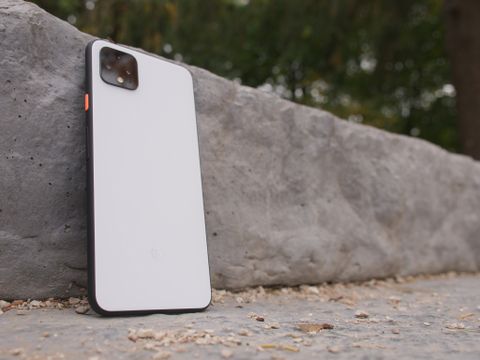Android Central Verdict
Bottom line: It's expensive and the battery doesn't last as long as I'd like, but that hasn't stopped me from thoroughly enjoying my time with the Pixel 4 XL. This is a phone where the overall experience is greater than the sum of its parts, and at the end of the day, it's the Android handset I most eagerly reach for. For anyone that values excellent cameras, reliable performance, and fantastic software, it's one of the best gadgets you can buy this year.
Pros
- +
Clean, simple design
- +
Truly incredible cameras
- +
Vibrant 90Hz display
- +
Now Playing, Active Edge, and other Google add-ons
- +
Live Caption is astonishingly good
Cons
- -
Battery life is mediocre at best
- -
Not having an ultra-wide camera is lame
- -
Few apps work with face unlock
Why you can trust Android Central
When reviews for the Pixel 4 and 4 XL went live back in October, Google's latest flagships were met with an overwhelming sense of disappointment. Sure, they did a lot of things right, but the poor battery life and weak value proposition left them in a dark cloud.
Those reviews made me anxious about my decision to order the Pixel 4 XL, and when it was finally delivered a few days later, I wasn't entirely sure what to expect. A few weeks later, however, this is quickly becoming a device I thoroughly enjoy using.
The Pixel 4 XL is expensive, and compared to some of its competitors, it doesn't seem like a very good deal. There may be smarter ways to spend your money on a new Android handset, but out of all the ones I've used this year, the Pixel 4 XL has stood out as the one I'm most eager to come back to time and time again. It's certainly not perfect for everyone, but for what I value most in a phone, it comes darn close.
Design and display
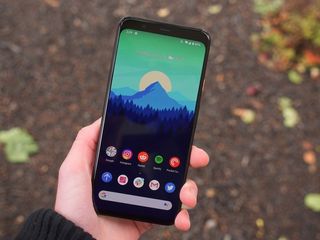
Ever since the first Pixel was released in 2016, Google's smartphones have had an iconic look to them. Even when the Pixel 3 moved away from the metal and glass combo to an all-glass back, it kept the two-tone design language to create for a familiar-looking package.
The Pixel 4 represents the biggest design shift we've seen for the Pixel series, and while it may not be the most visually-stunning, it has a sense of utilitarianism to it that I absolutely love.
While the Pixel 4's backside is made out of glass, the matte finish on the Clearly White and Oh So Orange models doesn't feel like it at all. Instead, touching it reminds me more of a premium polycarbonate. The same goes for the aluminum frame, which features a matte black paint job. The end result of these decisions is a phone that feels great to hold and always looks like it was just taken out of its box for the first time.




At least on the Clearly White model of the Pixel 4 XL I have, it barely picks up fingerprints at all. You may notice the occasional smudge here and there when holding it under the light just so, but compared to other glass-clad phones, it's a dream come true. The soft-touch frame and rounded edges also make this a very comfortable phone to hold, and thanks to the flat display, you never have to worry about your palm accidentally touching things you didn't intend to (I'm looking at you, OnePlus 7 Pro 😑).
The Pixel 4 XL's matte glass and frame feel outstanding.
Lastly, while the Pixel 4 XL doesn't have any color-shifting glass or pop-up selfie camera, I actually like how it looks. The panda/stormtrooper aesthetic of the Clearly White Pixel 4 XL is as clean as they come, and the orange power button offers a nice accent color to tie the whole package together. It's nothing too over-the-top, but it's also more eye-catching than a boring slab of a single color.
Moving on to the Pixel 4 XL's display, it's truly excellent.
The AMOLED panel kicks out vibrant colors with deep blacks, and with a Quad HD resolution, everything looks as crisp as can be. The display also gets really dim, which allows for comfortable use at night and early in the morning.
Above all of that, though, my favorite thing about the Pixel 4 XL's screen is the 90Hz refresh rate. This is a feature I've become increasingly obsessed with on smartphones, as it makes everything you do feel faster and more responsive. Google's implementation for this on the Pixel 4 series has been a bit funky, but things have improved since launch.

When the Pixel 4 and 4 XL first launched, it was quickly discovered that the 90Hz functionality was disabled once the screen brightness went below 75%. At that point, it would revert back to 60Hz. With the November 2019 security patch, however, Google's changed things so that it works as follows:
- On the Pixel 4, the 90Hz feature turns off when the brightness goes below 42%.
- On the Pixel 4 XL, the 90Hz feature stays on regardless of how bright or dim the screen is
As someone that wants to see the 90Hz goodness whenever possible, I'm really glad Google made the changes that it did. The 90Hz implementation on the Pixel 4 XL is fantastic, and not being blocked from using it just because I enjoy a dimmer brightness level is a welcomed update.
Cameras — oh the cameras
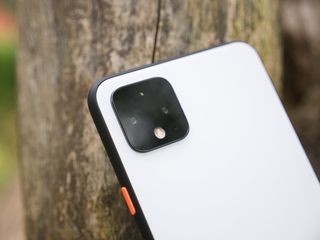
If there's one thing that makes the Google's Pixel phones iconic, it's their cameras. Google's computational magic for image processing has allowed the Pixels to stand out as some of the best phones for photography, and the Pixel 4 XL is no different.
I don't take a ton of pictures with my phone, but when I do, I want the end result to look as good as it possibly can. I also want to be able to rely on my phone to take a good picture no matter what setting or environment I'm in. Those are two things the Pixel 4 XL does with ease.
Specs-wise, the Pixel 4 XL is equipped with a 12MP primary camera and 16MP telephoto camera with a 2x optical zoom. I do wish that Google had also included an ultra-wide lens, but the quality of the photos I've taken so far have quickly made up for the lack of a third sensor.








When shooting in daylight or brightly-lit rooms, photos look fantastic. Colors are vibrant while staying true-to-life, the phone handles different levels of exposure with ease, and the 16MP telephoto camera can capture a remarkable level of detail.
Being able to rely on the Pixel 4 XL to take great-looking photos whenever I whip it out of my pocket is great, but if there's one aspect of the camera package that I've enjoyed the most, it's the astrophotography mode. This is an upgrade to Google's already impressive night mode, and it essentially takes an ultra-long shutter time of low-light environments to create for a final image that's often jaw-dropping.
Picture 1 — iPhone 11 Pro
Picture 2 — Pixel 4
Google's astrophotography mode is legit 🔥 pic.twitter.com/VLMZfbzvj3Picture 1 — iPhone 11 Pro
Picture 2 — Pixel 4
Google's astrophotography mode is legit 🔥 pic.twitter.com/VLMZfbzvj3— Joe Maring (@JoeMaring1) October 25, 2019October 25, 2019
You'll need to make sure the Pixel 4 XL stays dead still while taking a photo of the stars, which means propping it up against something or using a tripod. The last picture in the gallery above was taken with the astrophotography setting, and it required a four-minute shutter time. It's a shooting mode that requires a bit of patience, but once all is said and done, the picture that's churned out proves to be well worth the wait.
Performance and software
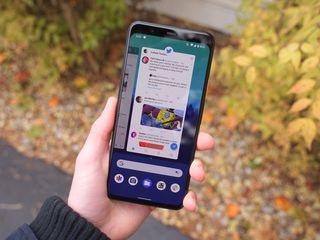
In addition to fantastic cameras, there's something else that's stuck with Google's Pixel phones — not having enough RAM. The Pixel, Pixel 2, Pixel 3, and Pixel 3a all shipped with a measly 4GB of RAM, and compared to other devices rocking anywhere from 6, 8, or 12GB, it looked pretty pathetic. With the Pixel 3, in particular, it was so bad that opening the camera would kill any song or podcast you had playing in the background.
With that in mind, I'm happy to report that performance on the Pixel 4 XL has been great. The Snapdragon 855 paired with 6GB of RAM isn't the most technically impressive combo you can find in a smartphone right now, but it's more than enough horsepower for just about any task you throw at it.
I've yet to encounter any sort of performance issues with the Pixel 4 XL.
Daily apps like Twitter, Gmail, YouTube, and Reddit all perform without a hitch, and even graphically intense games, such as Call of Duty Mobile, run incredibly well and are set to high graphic levels by default. Thanks to the 90Hz refresh rate, swiping through menus and scrolling through timelines on social media feels wickedly smooth.
Along with the high-end chipset and additional RAM, I also have to credit Google's software for how snappy the Pixel 4 XL is. Software on Google phones has shifted from "stock Android" to a "Pixel experience," but whatever you want to call it, it's one of my favorite ways to use the OS.
Google's take on Android 10 is easy-to-navigate, free of any unwanted clutter, and the software additions it does add feel genuinely helpful (more on that later).
Furthermore, along with a great software experience today, the benefit of buying a Pixel phone is that things are guaranteed to keep getting better as time goes on. The Pixel 4 XL comes with three years of guaranteed software updates and security patches, meaning the phone will stay up-to-date through at least October 2022. That's not quite on par with the level of update commitment you find with Apple's iPhones, but in the Android space, that's about as good as it gets.
Infamous battery life
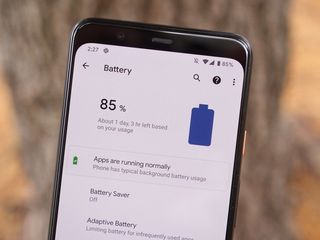
I prefaced it quite a bit in the intro for this review, so I suppose it's time I talk about battery life. Battery life on the Pixel 4 XL is not good, but it's also not as horrible as I was anticipating.
The below screenshots represent a pretty average day for me. With fairly regular use of Twitter, Instagram, Reddit, and some time spent messing with the camera — along with an endless stream of notifications — I saw 4 hours and 18 minutes of screen-on-time. Keep in mind, that was with the ambient display enabled and forcing the 90Hz refresh rate to be on all the time.
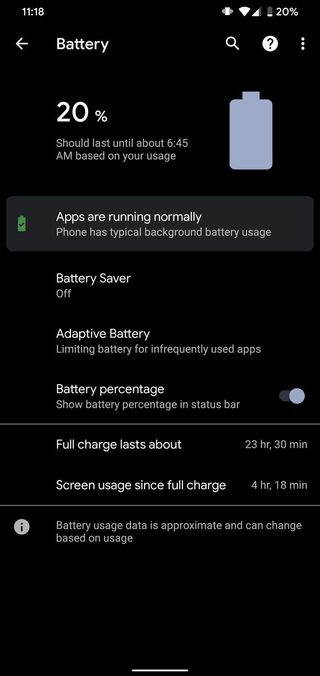
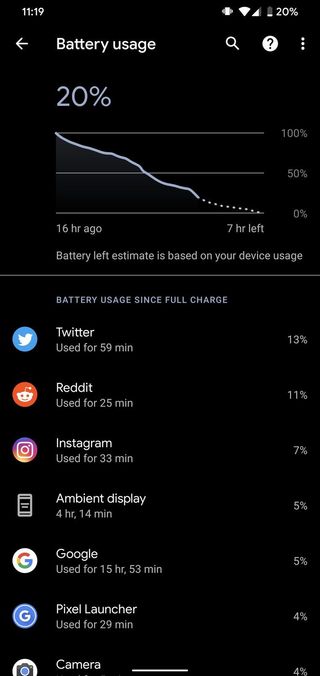
Source: Joe Maring / Android Central
There are plenty of other phones out there with substantially better endurance (the ASUS ROG Phone 2 and OnePlus 7T come to mind as some of the latest examples), and in a lot of cases, they cost less than the Pixel 4 XL.
If you're someone that's frequently on the road or without access to a power source, the Pixel 4 XL could prove to be an annoying daily driver. Light-to-moderate usage of it will allow you to get through a full day on a single charge, but as you start playing games, streaming video, or doing turn-by-turn navigation, it won't be uncommon to seek out a charger in the early evening or late afternoon.
Seeing as how I work from home with a wireless charger next to my computer, this hasn't been too big of an issue for my personal use. I throw the Pixel 4 XL on the charger in the morning after I wake up, and while it's propped up on my Qi charging stand, I can still use it for quick spurts. Once it's at 100%, I take it off and go about my day.
Not everyone has that same convenience of always being able to top-up their phone, but if you are, I wouldn't stress out quite as much about the Pixel 4 XL's battery. It's still not great, but I've been able to work with it just fine.
All of Google's extra features
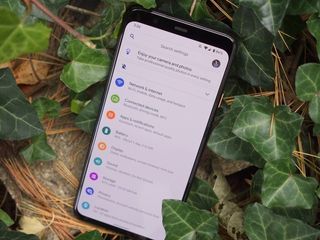
At the top of this review, I mentioned that the Pixel 4 XL is a phone that's greater than the sum of its parts. There are so many little features here and there Google sprinkles throughout the phone, and as you use each one in your daily use, they add up to create for an experience you can't get on any anything else.
One great example has to do with the Pixel 4 XL being the first phone in which Google's moved its language-processing unit to work on-device rather than needing to communicate with its servers. This results in the Google Assistant and voice dictation in Gboard being considerably faster, effectively understanding your words the second they come out of your mouth. As such, it makes both of these things more reliable and enjoyable to use.
Speaking of language processing, the Pixel 4 XL also comes with Live Caption and Google's new Recorder app.
Live Caption can be enabled at any time via the Pixel's volume menu, and when it's turned on, Live Caption transcribes any media that's playing on your phone. It works for podcasts, YouTube videos, movies, and virtually anything else with spoken language. Not only is it a game-changer for people that are deaf/hard-of-hearing, it's also a nice convenience for those times when you want to consume media on your phone without cranking up the volume.
All of Google's extra features add legitimate value to the Pixel experience.
The Recorder app is just as impressive, offering real-time transcription of any audio you record and allowing you to go back and search for specific words/phrases.
Oh, and then there's the new collection of Motion Sense gestures. These are powered by Google's Soli radar sensors, and they allow you to control certain aspects of the Pixel 4 XL by just waving your hand over the phone. Right now, that includes snoozing alarms, silencing incoming calls, and skipping through tracks in media apps like Spotify, Pandora, YouTube, etc.
I can see why some people consider Motion Sense to be nothing more than a tacked-on gimmick, but it's a feature I've been genuinely happy with. I do think there's more Google could be doing with it, but even in its early days, I've been getting more joy/usefulness out of Motion Sense than anything else.
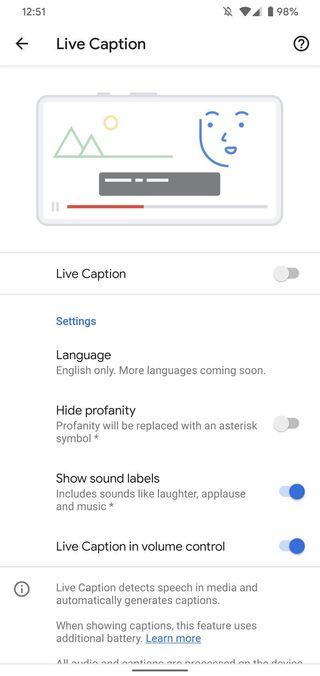
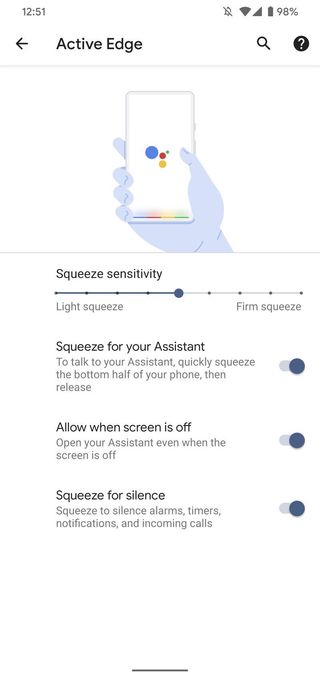

Source: Joe Maring / Android Central
Staples from previous Pixels are here, too, and they're as awesome as ever. Active Edge, the feature that allows you to squeeze the sides of your phone to invoke Google Assistant, is present on the Pixel 4 XL and is undeniably my favorite way to get the Assistant's attention. Now Playing has also stuck around, constantly listening for songs and showing you the title and artist on your lock screen. Think of it like having Shazam always running, except it works offline and doesn't eat up your battery.
You'll also find a new UI customization suite, Google's genuinely helpful Digital Wellbeing tools, and — for the first time on a Pixel phone — you can swipe down from anywhere on the home screen to access your notifications.
All of these features make using the Pixel 4 XL that much more enjoyable, even if they aren't very exciting to talk about on their own.
The face unlock conundrum

With the Pixel 4 XL, Google chose to forgo a fingerprint sensor and instead use a new face unlock system as the only form of biometric authentication for the phone. After using and loving Face ID on the iPhone XS and 11 Pro, I was ecstatic for Google to offer something similar on an Android phone.
Face unlock itself works really well. Setup takes just a few seconds, and once you're done, it works shockingly fast. You press the power button, and less than a second later, face unlock scans you face, bypasses the lock screen, and gets you right to your home screen. The Soli radar system makes the whole process even faster, as it can detect when you're picking up the Pixel 4 XL and get the screen turned on and ready to scan your face before you can even press the power button.
For the apps that support the Pixel 4 XL's face unlock, the experience is just as good. After opening 1Password, there's a small prompt at the bottom of the screen to indicate that face unlock is looking for my face, and once it finds it, I'm ready to start going through my passwords just like that.
When face unlock works, it's nothing short of magic. It's just as good as Face ID on the latest iPhones, if not better, in the sense that you don't need to swipe up on the lock screen to get inside your phone after your face is confirmed. Unfortunately, at least in its current state, face unlock on the Pixel 4 XL comes with a few big drawbacks.
Face unlock on the Pixel 4 is awesome — it's just a shame such few apps actually work with it.
For starters, face unlock has room to be more secure. Face unlock will scan and register your face regardless if your eyes are open or closed, meaning someone could grab your Pixel 4 XL, hold it up to your face while you're sleeping, and get into your phone without a problem. Google has said that it'll add an option in which face unlock requires the user's eyes to be open before it works, but won't be available until an update landing "in the coming months." There's also no option for adding an alternative appearance the way you can with the iPhone's Face ID, meaning you get one scan of your face for the Pixel 4 XL to work with and that's it.
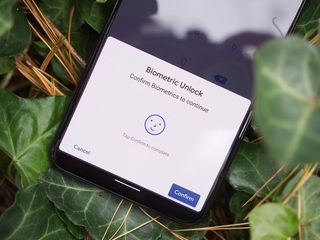
The whole eyes closed thing is a significant security risk, but the thing about face unlock that irks me the most is its incompatibility with Android apps. At the time of publishing this review, just nine apps work with face unlock, with three others expected to work with it in the future with no set date as to when that'll happen.
There are some big names that work with face unlock, most notably 1Password, LastPass, and Venmo, but apps like American Express, Bank of America, Chase, Capital One, Discover, and just about every banking/credit card app isn't compatible. In those instances, you have to revert back to a PIN, password, or pattern to access those sensitive applications. It can make using the Pixel 4 XL feel like a phone from five years ago before biometric authentication was a mainstream feature, and it's definitely one of my biggest gripes with the entire phone.
This is something that should get better as time goes on, but right now, that future remains about as unclear as it could be.
Pixel 4 XL Worthy of the $899 price

Do I wish the Pixel 4 XL's battery lasted longer? Absolutely. Do I think face unlock feels half-baked with the middling app support? Of course. Do I wish Google was offering more than 64GB of unexpandable storage for the $899 base model? You know it.
This is not a perfect phone, and you shouldn't go into buying it with that expectation. It has its fair share of problems, and they're problems that absolutely should be voiced to Google in hopes of getting them resolved with software updates or with the Pixel 5 in 2020.
4 out of 5
However, the Pixel 4 XL stands out for the fact that it still manages to offer an overwhelmingly great user experience even with those issues weighing it down. The downsides are annoying, but the things the Pixel 4 XL does right, it does so better than anyone.
I've had a blast using the Pixel 4 XL as my go-to Android phone over the last few weeks, and I can't wait for it to stick around in my pocket for the months to come.
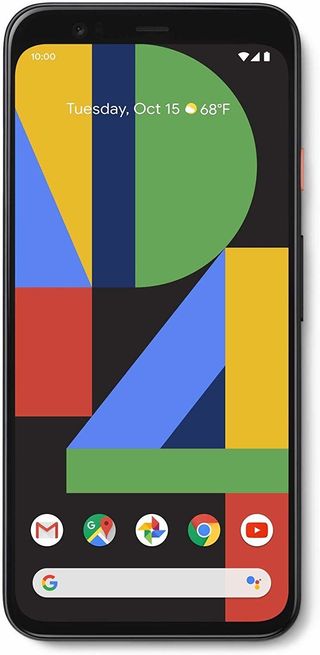
It's expensive and the battery doesn't last as long as I'd like, but that hasn't stopped me from thoroughly enjoying my time with the Pixel 4 XL. This is a phone where the overall experience is greater than the sum of its parts, and at the end of the day, it's the Android handset I most eagerly reach for to use. For anyone that values excellent cameras, reliable performance, and fantastic software, it's one of the best gadgets you can buy this year.
Joe Maring was a Senior Editor for Android Central between 2017 and 2021. You can reach him on Twitter at @JoeMaring1.
